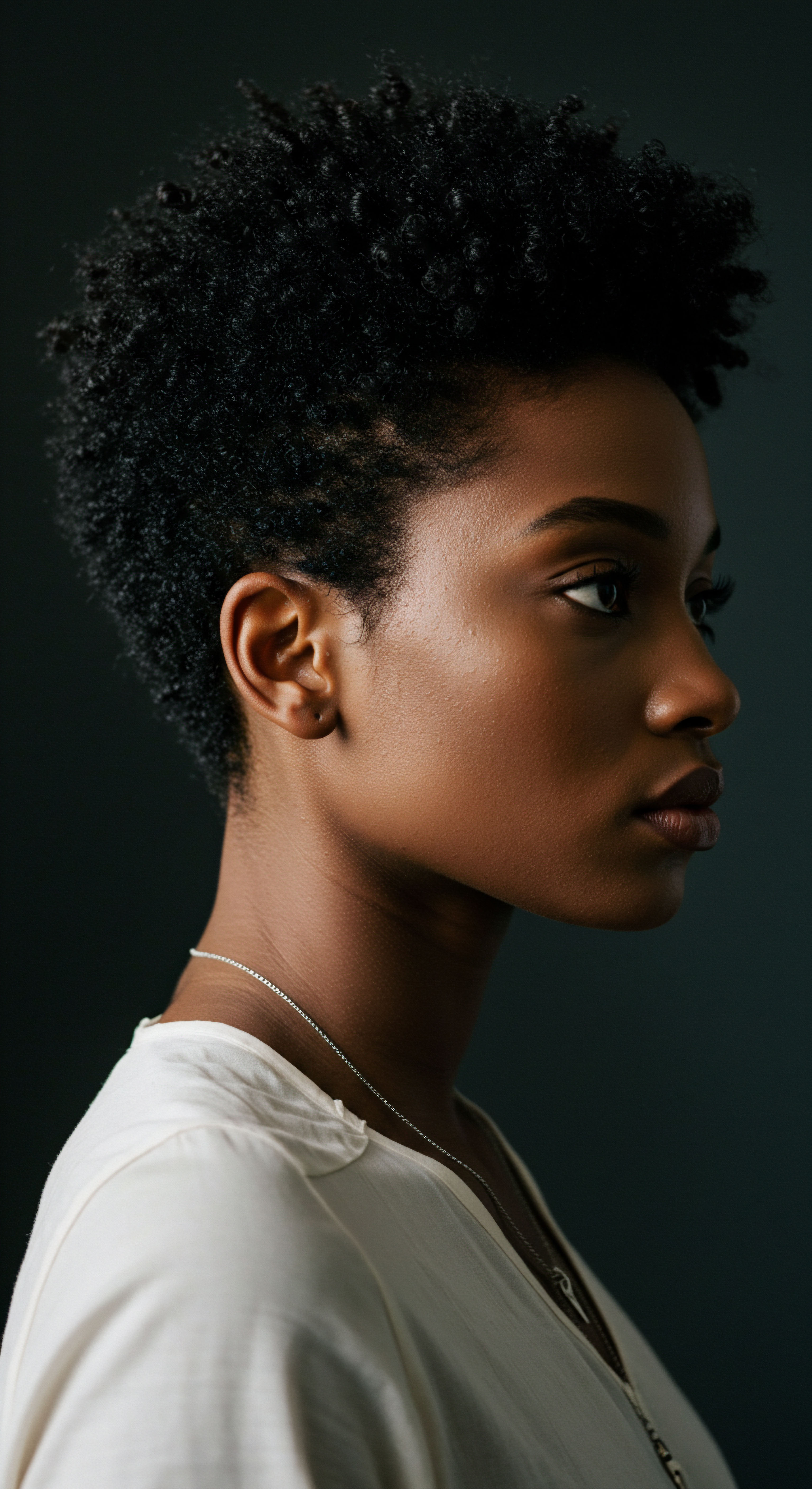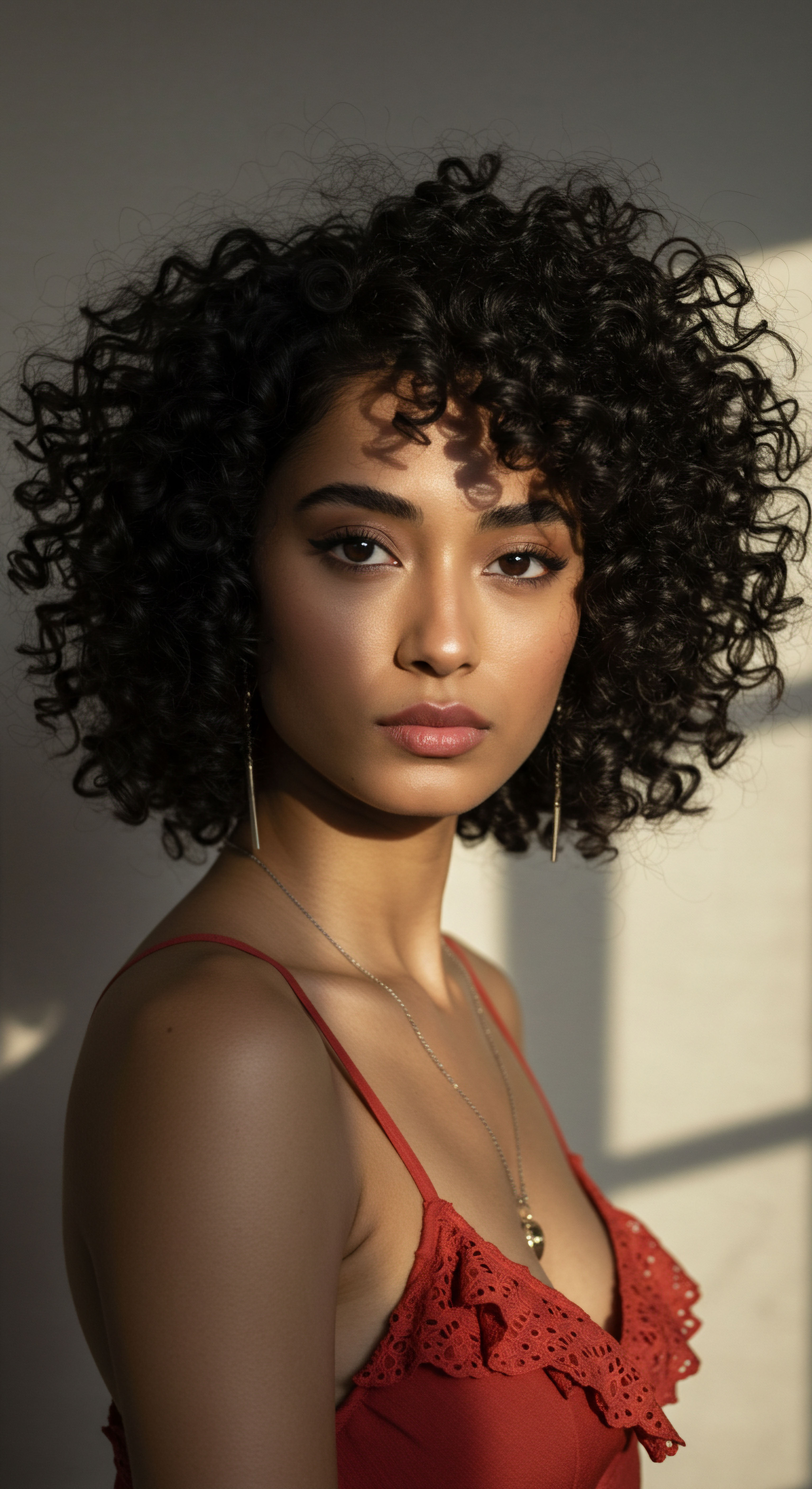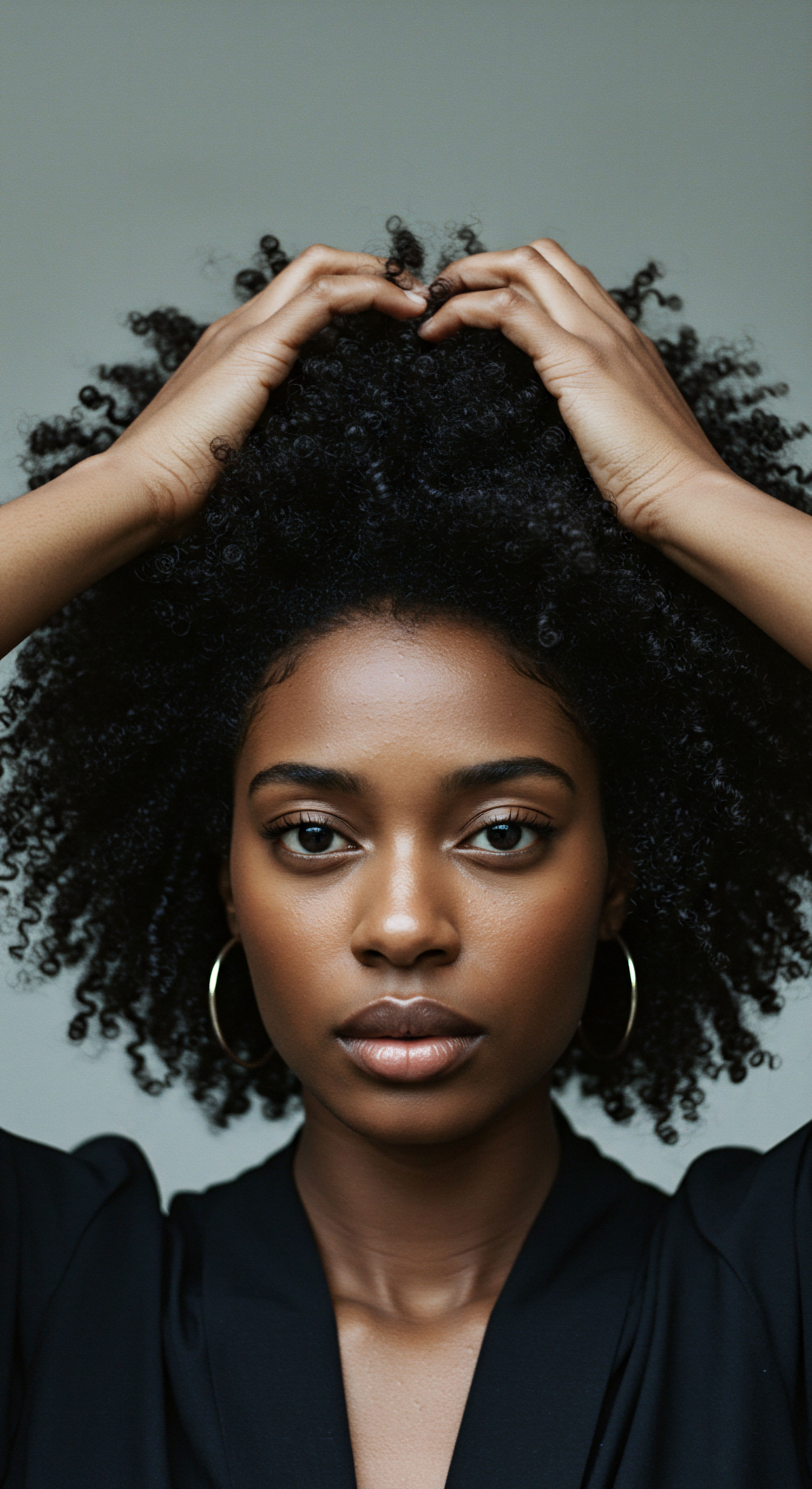
Fundamentals
Within the vast and often mystifying world of hair wellness, particularly for those graced with the intricate beauty of textured strands, a microscopic inhabitant frequently enters our conversations ❉ Malassezia. At its most straightforward, Malassezia refers to a genus of yeasts, single-celled fungi, that naturally reside on the skin and scalp of nearly all warm-blooded animals, including humans. This presence is typically benign, a silent partner in our dermal ecosystem, contributing to the delicate balance of our skin’s surface. The fundamental meaning of Malassezia, then, begins with its ubiquitous, often unnoticed, existence.
Consider Malassezia not as an unwelcome intruder by default, but rather as a quiet resident. These tiny organisms are lipophilic, which means they are drawn to and thrive on lipids—the natural oils, or sebum, produced by our sebaceous glands. Our scalp, a naturally oily environment, provides a welcoming home for these yeasts.
Their role in a healthy scalp is largely symbiotic; they consume some of the excess oils, and in turn, contribute to the complex microbial community that guards our skin. Understanding this foundational relationship is the first step toward deciphering the often-misunderstood connection between Malassezia and various scalp conditions, especially within the context of caring for textured hair, where oil application and moisture retention are paramount practices.
Malassezia represents a genus of naturally occurring yeasts residing on the human scalp, typically in a harmless, symbiotic relationship with our skin’s oils.

Malassezia’s Presence on the Scalp
The human scalp offers a rich, lipid-laden environment, an ideal habitat for Malassezia. This fungal genus encompasses several species, with Malassezia Globosa and Malassezia Restricta being the most commonly isolated from human scalps. Their preference for lipids means they are found in areas rich in sebaceous glands, such as the scalp, face, and upper torso. For individuals with textured hair, the natural architecture of the hair follicle and the scalp’s curvature can sometimes influence sebum distribution, creating micro-environments that might favor these yeasts.
The interaction between Malassezia and the scalp is dynamic. While normally harmless, certain factors can disrupt this delicate balance, leading to an overgrowth of these yeasts. Such factors include changes in sebum production, shifts in the scalp’s pH, alterations in the skin barrier, or even environmental humidity.
When Malassezia populations proliferate beyond their typical bounds, they can trigger an inflammatory response in susceptible individuals. This inflammatory cascade often manifests as the familiar flakes and itch associated with dandruff, or the more persistent redness and scaling of seborrheic dermatitis.

Early Signs and Significance for Textured Hair
For those tending to coils, curls, and waves, recognizing the early signals of an imbalanced scalp environment is a crucial aspect of hair wellness. The initial manifestations of Malassezia overgrowth often include an increase in scalp itchiness, a sensation that can be easily dismissed or attributed to dryness. This itch may be accompanied by small, white flakes that adhere to the hair strands or settle on clothing. The significance of these seemingly minor irritations for textured hair communities cannot be overstated; they are not merely cosmetic nuisances but potential indicators of underlying scalp disharmony.
The unique structural properties of textured hair, from its elliptical cross-section to its varied curl patterns, can affect how products are distributed and how easily the scalp is cleansed. This can, at times, create conditions that inadvertently encourage Malassezia proliferation. For instance, the very strategies employed to retain moisture in textured hair, such as infrequent washing or the generous application of heavier oils and butters, can sometimes create an occlusive layer on the scalp, potentially trapping moisture and sebum.
While beneficial for the hair shaft, this microclimate on the scalp can become an inviting space for Malassezia to flourish if not managed thoughtfully. Therefore, a foundational understanding of Malassezia is not just about its biological presence; it is about recognizing its potential implications for daily textured hair care practices.
- Yeasts ❉ Malassezia is a type of yeast, a single-celled fungus.
- Lipophilic ❉ These yeasts are drawn to and feed on lipids, or oils, naturally found on the scalp.
- Sebum ❉ The natural oils produced by the scalp’s sebaceous glands provide the primary food source for Malassezia.
- Symbiotic ❉ In a healthy state, Malassezia exists in a balanced relationship with the scalp’s other microorganisms.

Intermediate
Moving beyond the foundational understanding of Malassezia as a common scalp resident, we delve into its intermediate meaning, exploring its active role in various scalp conditions and its practical implications for textured hair care. Here, the Malassezia transforms from a mere biological presence into a key player in the narrative of scalp health, particularly when its delicate balance is disturbed. This section clarifies how an overabundance of Malassezia can disrupt the scalp’s serene state, leading to conditions that impact the comfort and confidence of those with curls and coils.
The primary manifestation of Malassezia overgrowth is Seborrheic Dermatitis, a chronic inflammatory skin condition affecting areas rich in sebaceous glands. When this condition presents on the scalp, it is commonly known as dandruff. While dandruff is often perceived as a minor annoyance, its intermediate meaning reveals a more complex interplay between yeast activity, individual sensitivity, and the scalp’s immune response. The yeasts metabolize triglycerides present in sebum, releasing irritating fatty acids that can trigger inflammation and accelerated skin cell turnover.
This rapid shedding of skin cells leads to the characteristic flakes, which can range from fine and white to larger, yellowish, and oily. The itch, a persistent companion to these flakes, arises from the inflammatory process.
Malassezia’s intermediate meaning involves its active role in scalp conditions like dandruff and seborrheic dermatitis, arising from an overgrowth that disrupts the scalp’s delicate balance.

Malassezia and Scalp Conditions ❉ A Deeper Look
The development of seborrheic dermatitis, often driven by Malassezia, is not simply a matter of yeast presence; it involves an individual’s unique immunological response to these organisms. Some individuals are more sensitive to the metabolic byproducts of Malassezia, leading to a more pronounced inflammatory reaction. Environmental factors, stress, hormonal fluctuations, and even diet can influence sebum production and the scalp’s overall health, indirectly affecting Malassezia populations. For individuals with textured hair, the challenges can be compounded by certain hair care practices that, while aiming to protect and nourish the hair shaft, may inadvertently create a conducive environment for Malassezia to flourish on the scalp.
For example, the widespread use of heavy oils, butters, and creams to seal moisture into textured hair, while beneficial for strand hydration, can sometimes lead to product build-up on the scalp. This accumulation can create an occlusive layer that traps sebum and moisture, limiting the scalp’s ability to breathe and providing an abundant food source for Malassezia. Similarly, less frequent washing, a common practice to preserve moisture and intricate hairstyles, can allow Malassezia populations to grow unchecked. This is not to say these practices are inherently problematic; rather, it highlights the importance of thoughtful product selection and cleansing routines that address both hair and scalp needs.

Practical Applications in Textured Hair Care
Understanding Malassezia at an intermediate level allows for more informed decisions in daily hair care rituals. This includes recognizing the signs of an imbalance and knowing when to introduce targeted solutions. Many anti-dandruff shampoos contain active ingredients like Pyrithione Zinc, Selenium Sulfide, or Ketoconazole, which possess antifungal properties designed to control Malassezia populations. Integrating these treatments thoughtfully into a textured hair regimen can be a transformative step for scalp health.
Consider the rhythm of your hair care. If protective styles are worn for extended periods, or if heavy products are used regularly, incorporating a clarifying or antifungal shampoo periodically becomes a crucial balancing act. The goal is to maintain a healthy scalp microbiome, where Malassezia exists in harmony, without stripping the hair of its essential moisture.
This might involve techniques like pre-pooing with lightweight oils, gentle scalp massages to loosen debris, and ensuring thorough rinsing. The meaning of Malassezia here extends to its practical implication ❉ it guides us toward a holistic approach to textured hair care, one that acknowledges the intricate connection between scalp biology and styling practices.
- Seborrheic Dermatitis ❉ A common inflammatory scalp condition caused by Malassezia overgrowth.
- Dandruff ❉ The flaky, itchy manifestation of seborrheic dermatitis on the scalp.
- Antifungal Agents ❉ Ingredients like pyrithione zinc and ketoconazole target Malassezia to restore scalp balance.
- Product Build-Up ❉ Accumulation of hair products on the scalp can create an environment favorable for Malassezia.
| Condition Dandruff (Pityriasis capitis) |
| Primary Symptoms Flaking (white, loose), mild to moderate itchiness. |
| Common Triggers/Exacerbators Stress, infrequent washing, product residue, environmental factors. |
| Condition Seborrheic Dermatitis |
| Primary Symptoms Persistent flaking (often yellowish, oily), redness, intense itching, inflammation. |
| Common Triggers/Exacerbators Hormonal changes, stress, certain medications, neurological conditions, impaired immune function. |
| Condition Folliculitis (Malassezia-related) |
| Primary Symptoms Small, itchy, pus-filled bumps (pustules) around hair follicles. |
| Common Triggers/Exacerbators Occlusion, excessive sweating, oily skin, topical steroid use. |
| Condition Understanding these conditions helps in targeted care for textured hair. |

Advanced
At an advanced echelon of understanding, Malassezia transcends its straightforward biological classification to embody a complex interplay of mycological specificity, host immunology, and socio-cultural dimensions within the landscape of textured hair health. The true explication of Malassezia, from an expert perspective, recognizes it not merely as a yeast that causes flakes, but as a critical bio-indicator reflecting the intricate ecological dynamics of the scalp microbiome, particularly in diverse hair types. This advanced interpretation requires a deep dive into its species-specific roles, genetic predispositions, and the often-overlooked influence of historical hair care practices and their modern iterations within Black and mixed-race hair communities.
The meaning of Malassezia, at this sophisticated level, involves its nuanced genetic variability. While Malassezia Globosa and Malassezia Restricta are the most common human isolates, a broader spectrum of species exists, each potentially exhibiting different enzymatic activities and immunological profiles. For instance, research suggests that the dominant Malassezia species can vary across different ethnic groups, possibly influencing the clinical presentation and severity of scalp conditions. This specificity is crucial, as it implies that a “one-size-fits-all” approach to managing Malassezia-related conditions may fall short, particularly for textured hair, where hair fiber structure and common grooming practices introduce additional variables.
Malassezia, at an advanced level, represents a complex bio-indicator of scalp ecosystem health, influenced by species diversity, host genetics, and cultural hair practices within textured hair communities.

Malassezia and the Textured Hair Microbiome ❉ A Scientific Interrogation
The scalp microbiome, a bustling community of bacteria, fungi, and viruses, plays a pivotal role in maintaining dermal homeostasis. Malassezia exists within this delicate equilibrium. Disruptions, whether from internal physiological shifts or external environmental stressors, can tilt the balance, allowing Malassezia to transition from commensal (harmless resident) to pathogenic (disease-causing). For textured hair, this transition is particularly salient.
The very strategies that protect textured hair from dryness and breakage—such as co-washing, infrequent shampooing, and the application of occlusive products—can, paradoxically, create a microenvironment on the scalp that favors Malassezia overgrowth. The debate around the frequency of washing textured hair, often driven by concerns about moisture retention, can sometimes overshadow the imperative of scalp hygiene.
A compelling, albeit often under-discussed, aspect of Malassezia’s relevance to textured hair lies in the potential for differential susceptibility and response. A study published in the Journal of Clinical and Aesthetic Dermatology by Irshad et al. (2020) , while not exclusively focused on Malassezia, highlighted the variability in scalp microbiome composition across different ethnic groups. Their findings suggested that differences in skin physiology and hair care practices contribute to distinct microbial signatures.
This data point underscores the expert insight that generic anti-dandruff solutions, formulated primarily based on studies on Caucasian hair and scalp types, might not always address the unique challenges faced by individuals with textured hair. The structural differences in hair follicles, the density of hair, and the common practice of using heavier, oil-based products can alter the scalp’s microclimate, potentially leading to specific Malassezia species dominance or altered inflammatory responses. The long-term consequence of misaligned treatment protocols can be chronic scalp irritation, persistent flaking, and in some severe cases, conditions that mimic or contribute to hair loss disorders like traction alopecia, often seen in textured hair due to tension from styling. This emphasizes the need for tailored research and product development that acknowledges the specific needs of Black and mixed-race hair.

Cultural Context and Clinical Ramifications
The socio-cultural dimensions of Malassezia-related conditions within textured hair communities warrant a deeper analysis. For generations, hair care practices in Black and mixed-race communities have been intertwined with heritage, identity, and resilience. The use of natural oils and butters, passed down through families, often serves as a cornerstone of hair health and styling.
However, from an advanced trichological perspective, the continuous layering of certain non-water-soluble lipids without adequate cleansing can create an anaerobic, lipid-rich environment ideal for Malassezia proliferation. This is not to dismiss ancestral practices, but rather to understand their scientific implications and to adapt them for modern scalp health.
The clinical ramifications extend beyond simple flaking. Chronic Malassezia overgrowth can contribute to persistent pruritus (itching), leading to scratching that can damage the scalp barrier and increase the risk of secondary bacterial infections. Furthermore, the aesthetic burden of visible flakes can lead to significant psychological distress, impacting self-esteem and social interactions.
For individuals who already navigate societal pressures regarding their hair, managing a visible scalp condition can be particularly taxing. Therefore, an advanced understanding of Malassezia encompasses not only its mycological and immunological aspects but also its profound psychological and cultural significance, urging for culturally sensitive and scientifically informed solutions.

Future Directions and Expert Insights
The future of managing Malassezia in textured hair care lies in personalized approaches, informed by ongoing research into the scalp microbiome and the specific responses of diverse hair types. This involves developing diagnostic tools that can identify dominant Malassezia species and assess individual inflammatory markers. Expert insights suggest a move towards formulations that balance potent antifungal activity with ingredients that support the scalp’s barrier function and maintain hair moisture without contributing to build-up.
From a business and research perspective, there is a compelling need for more clinical trials specifically on textured hair types to validate the efficacy of existing and novel anti-Malassezia treatments. This could involve exploring the potential of prebiotics and probiotics to modulate the scalp microbiome, creating an environment less hospitable to pathogenic Malassezia overgrowth. The essence of Malassezia in this advanced context is a call to action ❉ a recognition that true hair wellness for textured strands requires a sophisticated, holistic, and culturally aware approach that moves beyond superficial symptom management to address the underlying microbial and immunological complexities.
- Microbiome ❉ The complex community of microorganisms residing on the scalp, where Malassezia is a key member.
- Commensal ❉ Describes Malassezia’s normal, harmless existence on the scalp without causing disease.
- Pathogenic ❉ Refers to Malassezia’s disease-causing potential when its population becomes unbalanced.
- Lipase Activity ❉ Malassezia yeasts produce lipases, enzymes that break down sebum into irritating fatty acids.
| Malassezia Species Malassezia globosa |
| Common Clinical Association Dandruff, Seborrheic Dermatitis |
| Notes on Prevalence/Relevance Most frequently isolated species from human dandruff. |
| Malassezia Species Malassezia restricta |
| Common Clinical Association Dandruff, Seborrheic Dermatitis |
| Notes on Prevalence/Relevance Often co-occurs with M. globosa, also highly prevalent. |
| Malassezia Species Malassezia furfur |
| Common Clinical Association Pityriasis versicolor, Seborrheic Dermatitis |
| Notes on Prevalence/Relevance Can be found on scalp, but more commonly associated with skin conditions. |
| Malassezia Species Malassezia sympodialis |
| Common Clinical Association Atopic Dermatitis, Seborrheic Dermatitis |
| Notes on Prevalence/Relevance Increasingly recognized in various skin conditions, including eczema. |
| Malassezia Species Species identification can inform targeted treatment strategies. |

Reflection
As we journey through the intricate layers of Malassezia’s presence on our scalps, a profound realization emerges ❉ this microscopic yeast is more than a scientific curiosity; it is a silent narrator in the story of our hair. For those with textured strands, where hair is often a profound expression of identity, heritage, and artistry, understanding Malassezia becomes an act of gentle reclamation. It allows us to move beyond generalized advice, inviting us to listen more closely to the unique whispers of our own scalp ecosystems. The true significance of Malassezia lies in its capacity to guide us toward a more informed, compassionate, and ultimately more effective approach to hair wellness, honoring both scientific understanding and the rich tapestry of cultural hair traditions.

References
- Irshad, S. et al. “Scalp Microbiome Composition Varies Across Different Ethnic Groups.” Journal of Clinical and Aesthetic Dermatology, vol. 13, no. 1, 2020, pp. 28-34.
- Dawson, T. L. “Malassezia globosa and restricta ❉ The key species in dandruff and seborrheic dermatitis.” Journal of Investigative Dermatology Symposium Proceedings, vol. 12, no. 2, 2007, pp. 19-21.
- Gupta, A. K. et al. “Seborrheic dermatitis.” Journal of the American Academy of Dermatology, vol. 54, no. 5, 2006, pp. 827-836.
- Slemp, C. C. et al. “The role of the skin microbiome in healthy and diseased states.” Journal of the American Academy of Dermatology, vol. 79, no. 2, 2018, pp. 362-371.
- Elewski, B. E. “Malassezia species in skin diseases.” Clinics in Dermatology, vol. 28, no. 2, 2010, pp. 154-159.
- Richard, G. & D. D. A. J. D. “Hair Care Practices in Individuals of African Descent.” Journal of the American Academy of Dermatology, vol. 76, no. 2, 2017, pp. 297-306.
- Prohic, A. & Kasumagic-Halilovic, E. “The role of Malassezia species in seborrheic dermatitis.” Journal of the European Academy of Dermatology and Venereology, vol. 27, no. 10, 2013, pp. 1269-1273.
- Akaza, H. et al. “Malassezia species on the scalp of healthy Japanese individuals.” Mycoses, vol. 53, no. 6, 2010, pp. 523-527.